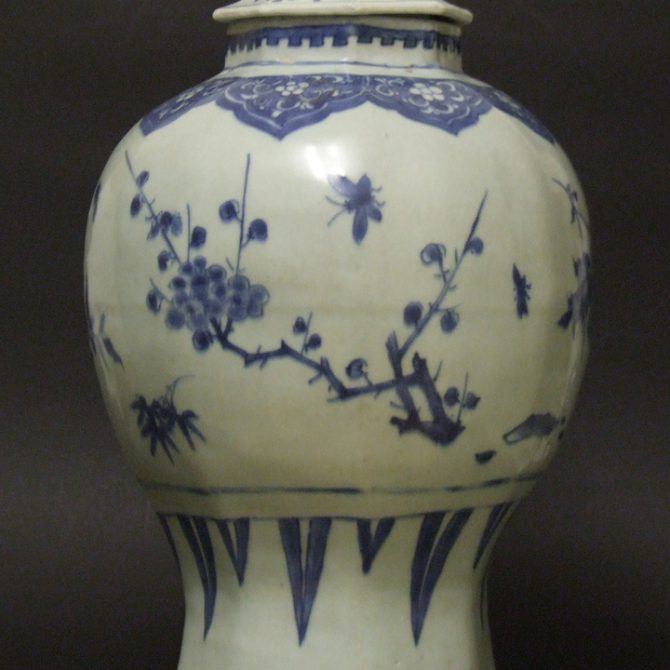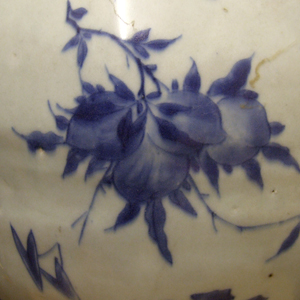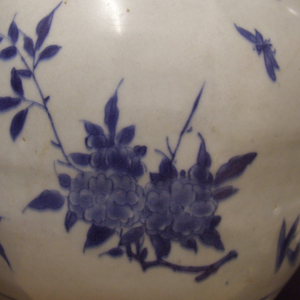
HATCHER CARGO c.1643. Transitional Porcelain.
A Hatcher Cargo Transitional Porcelain Octagonal Baluster Jar. Late Ming or Early Qing c.1643. The Neck Decorated with a Border of `Teeth` and Overlapping Lappets Reserved in Blue with Scrolling Flowers Left in the White. The Central Register is Decorated with `Floating` Flowering Branches, Including Orchids, Plum and Lotus. Below a Band of Stiff Leaves Pointing Downwards.
SOLD
- Condition
- Very good, the glaze is good for a shipwreck piece, minor fritting.
- Size
- Height : 37 cm (14 1/2 inches).
- Provenance
- Fine And Important Late Ming And Transitional Porcelain, recently recovered from an Asian vessel in the South China Sea. Property of Captain Michael Hatcher. Christie`s Amsterdam 14th March 1984. Label to Base : The Hatcher Collection Christie`s Amsterdam 14-03-1984. Ashdown House, Oxfordshire, built in the 1660`s for William, first Earl of Craven. 明代中国陶瓷 His father William Craven was born in a poor family in Appletreewick in North Yorkshire but moved to London, became wealthy, and was Lord Mayor of London in 1610. Craven fought for Frederick V on the Continent and fell in love with his wife, Elizabeth of Bohemia. Still being absent during the English Civil War, he supported this lady's brother, Charles I, financially rather than in person and, therefore, had all his lands - largely in Berkshire - confiscated. After the Restoration, he set about planning to build a vast palace for Elizabeth at Hamstead Marshall, but she died before construction began. Legend has it that Ashdown House, Oxfordshire, England, was also built for Elizabeth. After the Restoration he was rewarded with several Court offices and given an earldom. As a Privy Councillor he seems to have been diligent enough: Pepys in his Diary regularly mentions his attendance at the Committee for Tangier and his chairing the Committee on Fisheries. In the latter role Pepys was rather shocked by his bawdy language which Pepys thought improper in a councillor ( though perhaps natural in an old soldier). In 1678 we read of his presence at the historic Council meeting where Titus Oates first publicised, the Popish Plot Pepys' attitude to Craven varies in the Diary- on the one hand he calls him a coxcomb and criticises his chairing of the Fisheries Committee; at other times he is glad that Craven is his " very good friend". Whatever Pepys's opinion of him, Craven earned the lasting respect and gratitude of the people of London during the Great Plague when unlike the great majority of noblemen who fled to the country, he remained in London helping to maintain order and donating property for burial grounds.
- Stock number
- 21852
- References
- Transitional jars of this type can be seen in 17th Century Dutch Paintings by artists such as Simon Luttichuys (1610-1661 or 62) and J.D. de Heem (1606-1684). Dr. A.I. Spriggs in his paper read to the Oriental Ceramic Society `Oriental Porcelain in Western Paintings` illustrated a painting by C.Cruys containing a similar vessel see : Transactions of the O.C.S. Volume 36, plate 73d. The shape and design are of a type made only for export. T.Volker in `Porcelain and the Dutch East India Company` suggests that this form corresponds to the "Pots for Preserves" ordered from Jousit in 1643, Described as "Octagonal and Round" or "Half Round, Half Octagonal". For Hatcher jars of this type see our `Sold` section : a pair 13611, single jars with covers 19300, 19301, 19302, and for a Transition Porcelain jar of this type but not from the hatcher Cargo see 17591.
Information

